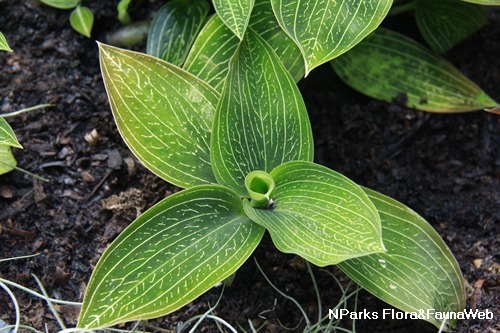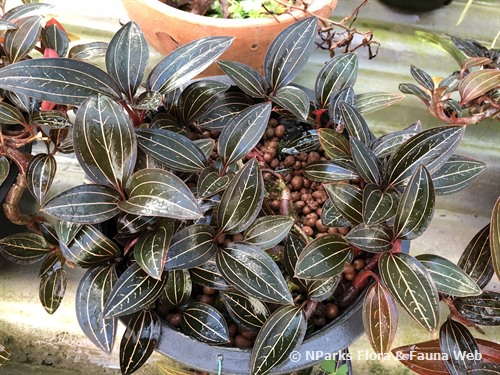.jpg)
Back
Ludisia discolor (green form)
| Family Name: | Orchidaceae |
| Synonyms: | Haemaria discolor |
| Common Name: | Jewel Orchid |
This Jewel Orchid is the green form of the Ludisia discolor which is much loved for its light green velvety leaves marked with whitish green veins. This herbaceous plant grows well as indoor plant under partial light on a well-drained, moist soil.
Name
Classifications and Characteristics
| Plant Division | Angiosperms (Flowering Seed Plants) (Monocotyledon) |
|---|---|
| Plant Growth Form | Herbaceous Plant |
| Lifespan (in Singapore) | Perennial |
| Mode of Nutrition | Autotrophic |
| Plant Shape | Shrubby |
| Maximum Height | 1 cm to 6 cm |
| Maximum Plant Spread / Crown Width | 1 cm to 4.5 cm |
Biogeography
| Native Distribution | South-Central and Southeast China, Myanmar, Thailand, Cambodia, Laos, Vietnam, Peninsular Malaysia, Borneo, Philippines, Sumatra. |
|---|---|
| Native Habitat | Terrestrial (Primary Rainforest) |
| Preferred Climate Zone | Tropical, Highland / Montane |
| Local Conservation Status | Non-native (Horticultural / Cultivated Only) |
| CITES Protection | True (Appendix II) |
Description and Ethnobotany
| Growth Form | Terrestrial orchid with erect growth habit. |
|---|---|
| Foliage | Bright green leaves (5 - 8 cm long) with whitish green venation. The velvety leaves are narrowly ovate to elliptic with entire leaf margin. |
| Stems | Succulent |
| Flowers | Small flowers of white petals with yellow center. They are arranged in spike inflorescences borne on long stalks (30 cm long) |
| Cultivation | This orchid is easy-to-grow. It should be planted in fertile, well-drained, but moist soil (eg., potting mix for African violets or a mixture of fine bark, coconut peat and isolite). Plants grow well in partial shade to shade (85 - 90%). It prefers moist air, so place potted plants next to other plants to increase humidity. Avoid overwatering which leads to root rot. |
| Etymology | The species epithet "discolor" means that the plant is composed of 2 different colours. |
Landscaping Features
| Landscaping | This species is grown for its ornamental foliage which has striking venation. It is suitable as an indoor plant and grows well in terrariums. |
|---|---|
| Desirable Plant Features | Ornamental Foliage |
| Landscape Uses | Container Planting, Terrarium, Interiorscape/ Indoor Plant |
Fauna, Pollination and Dispersal
| Seed or Spore Dispersal | Abiotic |
|---|
Plant Care and Propagation
| Light Preference | Semi-Shade, Full Shade |
|---|---|
| Water Preference | Moderate Water, Occasional Misting |
| Plant Growth Rate | Moderate |
| Rootzone Tolerance | Moist Soils, Well-Drained Soils |
| Planting Remarks | Use a well drained yet moisture retentive media for this species; although they can be grown as potted plants outdoors in shaded areas (e.g. under the shade of trees) under our local conditions, this species tends to perform better under cooler conditions (less than 25'c). It can be prone to attack by snails and slugs when grown outdoors. Do not allow media to become too wet and soggy as this can cause the plants to rot. |
| Transplanting Tolerance | Moderate |
| Maintenance Requirements | Moderate |
| Pest(s) | Chewing Insects, Sucking Insects |
| Propagation Method | Division |
Foliar
| Foliage Retention | Evergreen |
|---|---|
| Mature Foliage Colour(s) | Green, White |
| Mature Foliage Texture(s) | Smooth |
| Prominent Young Flush Colour(s) | Green, Green - Light Green, White |
| Young Flush Texture(s) | Smooth |
| Foliar Type | Simple / Unifoliate |
| Foliar Arrangement Along Stem | Spiral |
| Foliar Attachment to Stem | Petiolate |
| Foliar Shape(s) | Non-Palm Foliage (Oval) |
| Foliar Venation | Pinnate / Net |
| Foliar Margin | Entire |
| Foliar Apex - Tip | Acute |
| Foliar Base | Rounded / Obtuse |
| Typical Foliar Area | Notophyll ( 20.25cm2 - 45 cm2 ) |
| Leaf Area Index (LAI) for Green Plot Ratio | 3.5 (Shrub & Groundcover - Monocot) |
Non - Foliar and Storage
| Stem Type & Modification | Herbaceous |
|---|---|
| Root Type | Underground (Fibrous Root) |
Floral (Angiosperm)
| Flower & Plant Sexuality | Bisexual Flowers |
| Flower Colour(s) | White |
|---|---|
| Flower Texture(s) | Smooth |
| Flower Grouping | Cluster / Inflorescence |
| Flower Location | Axillary |
| Flower Symmetry | Bilateral |
| Flowering Period | A Few Times Yearly, Free-Flowering |
| Flowering Habit | Polycarpic |
Fruit, Seed and Spore
| Fruit Classification | Simple Fruit |
|---|---|
| Fruit Type | Dehiscent Dry Fruit |
Image Repository
Others
| Master ID | 32484 |
|---|---|
| Species ID | 6896 |
| Flora Disclaimer | The information in this website has been compiled from reliable sources, such as reference works on medicinal plants. It is not a substitute for medical advice or treatment and NParks does not purport to provide any medical advice. Readers should always consult his/her physician before using or consuming a plant for medicinal purposes. |

.jpg)

